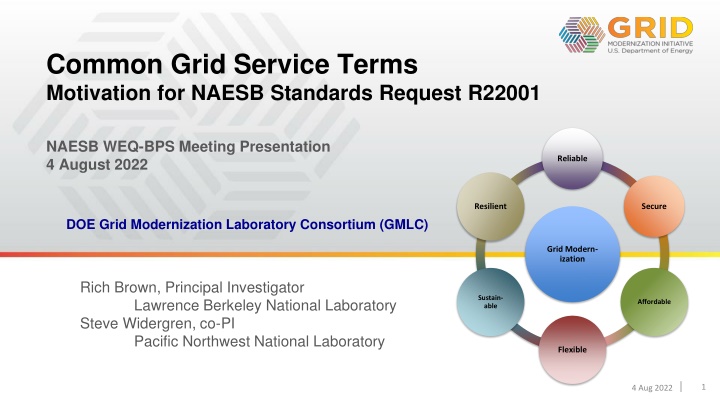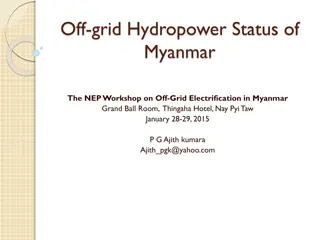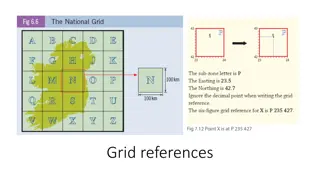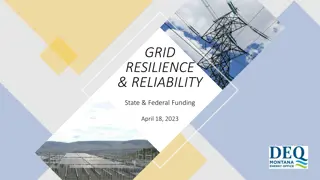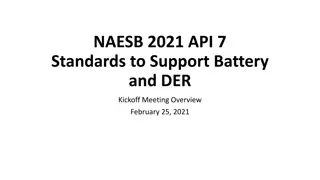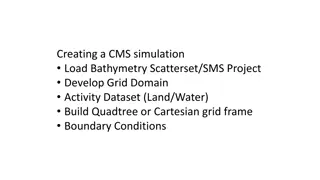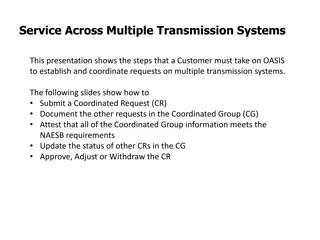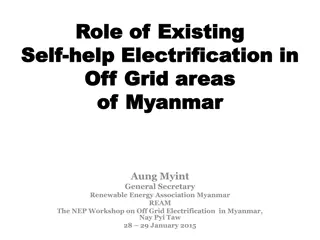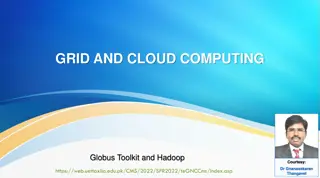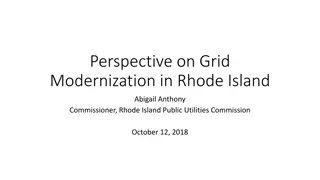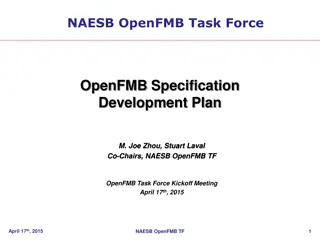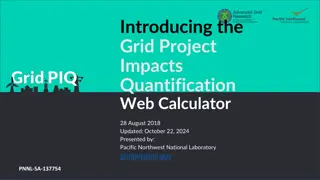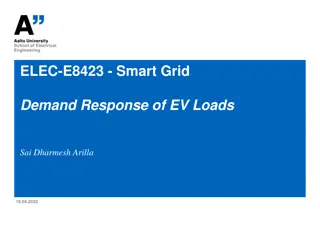Common Grid Service Terms for NAESB Standards Request R22001 - Meeting Presentation 4 August 2022
Topics covered include work plan, grid service types, energy schedule service attributes, desired outcome classification, and format of work product for the DOE Grid Modernization Laboratory Consortium meeting.
Download Presentation

Please find below an Image/Link to download the presentation.
The content on the website is provided AS IS for your information and personal use only. It may not be sold, licensed, or shared on other websites without obtaining consent from the author.If you encounter any issues during the download, it is possible that the publisher has removed the file from their server.
You are allowed to download the files provided on this website for personal or commercial use, subject to the condition that they are used lawfully. All files are the property of their respective owners.
The content on the website is provided AS IS for your information and personal use only. It may not be sold, licensed, or shared on other websites without obtaining consent from the author.
E N D
Presentation Transcript
Common Grid Service Terms Motivation for NAESB Standards Request R22001 NAESB WEQ-BPS Meeting Presentation 4 August 2022 Reliable Resilient Secure DOE Grid Modernization Laboratory Consortium (GMLC) Grid Modern- ization Rich Brown, Principal Investigator Lawrence Berkeley National Laboratory Steve Widergren, co-PI Pacific Northwest National Laboratory Sustain- able Affordable Flexible 1 4 Aug 2022
Topics Review desired outcome Work plan Common grid service types WEQ-000 mapping and comparison Energy schedule service Description Attributes Additional information: measurement, example operational objectives, origin of service Correspondence with existing service definitions: CAISO, SPP, PJM Reserve service Description Attributes Additional information: measurement, example operational objectives, origin of service Correspondence with existing service definitions: CAISO, SPP, PJM Next meeting: 23 Aug 2022, 1-4pm Central Homework: participants choose an existing energy schedule service definition and describe in common service form 2 4 Aug 2022
Desired Outcome of Effort Classification of a (small) set of grid services Common names for these grid-service types Clear definitions of the service types Parameterized performance expectations (i.e., electrical attributes, timing attributes) Accommodate necessary specialization Effort does NOT, Propose a uniform market policy on services Prescribe a solution for DER integration into wholesale electric markets Specify DER management technology or platforms 3 4 Aug 2022
Format of Work Product WEQ-000 Grid service name: 1- or 2-word title of the service Description: short (1- or 2-sentence) definition of the service WEQ-xxx Performance expectation: parameters that describe the expected performance delivered Electrical attributes: Electricity-related quantities or qualities (e.g., power, energy, voltage level) over the performance period. Electrical location: the physical location where the service is delivered in the electric system. Timing attributes: Delivery schedule: period over which the grid service is expected to take place. Delivery schedule notification: timing associated with notification that the delivery schedule for a service is established. Response time: Response time is the allowed elapsed time between the moment when the grid service is to start and the moment when the desired behavior meets the defined threshold for a given grid service. Additional information Performance measurement examples: typical ways the service is measured for verification Example service requestor operational objectives: applications for calling the service Origin of service definition: context or background on why the service exists 4 4 Aug 2022
Work Plan Completed: Scope of effort Review state of grid services Aug 4: Identify common grid service types Draft the common grid services descriptions for Energy schedule service Reserves service Aug 23: Draft common grid services descriptions for Regulation service Frequency response service Voltage management service Emergency service Sep 7: Reconcile WEQ-000 standard terminology Map existing grid services to common services Sep 27: Prepare draft material of common grid services for industry informal comment Continue mapping of existing grid services Oct ??? Address industry informal draft comments (if any) WEQ Executive Committee meeting 18 Oct Refine draft standard consensus recommendation Oct/Nov ??? Review refinements to draft standard Vote recommendation out of committee 5 4 Aug 2022
Reference Common Grid Services Energy Schedule Service: A service in which a resource is scheduled to produce or consume energy from an electrical Service Location over a specified scheduled period. Reserve Service: A service in which a resource commits availability to produce or consume power based upon instructions by the System Operator to meet reserve capacity requirements that are established to meet applicable reliability standards. Reserved assets would be engaged as needed during this period. Regulation Service: A service in which a resource provides an increase or decrease in real power production or consumption from an electrical Service Location over a specified scheduled period against a predefined real-power base point following a System Operator s signal. The signal interval is one to several seconds and the associated performance period is of a significantly shorter duration than the typical energy scheduling service performance period. Frequency Response Service: A service that uses the response of resources and load to arrest local changes in frequency (NERC 2021). Voltage Management Service: A service in which a resource can provide voltage support (raise or lower) within a specified upper and lower voltage range at an electrical location over a specified scheduled period. Emergency Service: A service that uses the capability of provider resources to energize without an outside electrical supply or quickly change energization levels during an electric grid emergency. See Gap Analysis workpaper for comparison to existing WEQ-000 terms 6 4 Aug 2022
Energy Schedule Service Energy Schedule Service: A service in which a resource is scheduled to produce or consume energy from an electrical Service Location over a specified scheduled period. Performance Expectation Electrical Attributes: Power: the power level of the resource for production or consumption over the performance period. Energy: the quantity of electric energy for production or consumption over the performance period. The agreement can specify the price for a quantity of energy at different power levels (a curve). Service Location: a NAESB defined term matching this definition: The physical location at which connection to the transmission or distribution system is made. Timing Attributes: Delivery schedule: the period of performance describes the start time and end time of the scheduled energy production or consumption. This can also be specified with a start time and a duration. Delivery schedule notification: The timing associated with notification that the delivery schedule for the energy service is established. For example, the results of a market process are published by specified times and notify the participants of their scheduled delivery of the service. 8 4 Aug 2022
Energy Schedule Service (cont.) Additional information Performance Measurement: The applicable Governing Documents specify how performance is measured. This is usually done with revenue grade meters that measure energy in intervals synchronized to the delivery schedule for the service. Periodic power measurements are also used. Operational Objective Examples: system peak load management, balance energy use with production, manage delivery limitations caused by electric flow constraints. Origin of Service Definition: Wholesale markets arrange for scheduled blocks of energy to match anticipated load. These are done in many forms including bilateral agreements between energy suppliers and energy users. They are also done in centrally-managed markets, such as run by independent market operators. In the wholesale situation the price and quantity of energy delivery over the performance period is negotiated ahead of time with information provided to an independent system operator for ensuring reliable system operation. The agreements also stipulate the penalties or fees for non- performance (over or under production and consumption). Most ISO/RTOs have real-time (5-minute to one hour) and day-ahead (next operating day) markets at the wholesale level. Some may also have real-time and day-ahead demand response energy scheduling programs with programs for retail customers to be able to respond to wholesale electricity prices. Participants are compensated based on the amount of reduction made during the delivery schedule interval. 9 4 Aug 2022
Energy Schedule Service Mapping Example Summary on next slide Further details in meeting whitepaper CAISO SPP PJM 10 4 Aug 2022
Electrical Attributes Timing Attributes Grid Entity/Service Delivery schedule notification Power Energy Service Location Delivery Schedule Amount of energy produced or consumed in each hourly interval in MWh each 24-hour period of the upcoming trading (i.e., operating) day. published at 1pm prior to the start of the trading day CAISO Day-Ahead Scheduled Energy Bid curves consist of MW, $/MWhr quantities producing node and delivering nodes. Amount of energy produced or consumed in each dispatch interval in MWh CAISO Hourly Real- Time Scheduled Energy Bid curves consist of MW, $/MWhr quantities or the upcoming trading (i.e., operating) hour published ~45 minutes prior producing node and delivering nodes. Amount of energy produced or consumed in each dispatch interval in MWh Electrical nodes (ENodes) represent the physical connection points published at 1pm prior to the start of the operating day SPP Day-Ahead Market for Energy Bid curves consist of MW, $/MWhr quantities 24-hour period of the upcoming operating day Amount of energy produced or consumed in each of the real-time dispatch (i.e., schedule) intervals in MWh Electrical nodes (ENodes) represent the physical connection points SPP Real-Time Balancing Market for Energy every 5-minute operating interval in the operating hour not published, 5-minute dispatch decisions Bid curves consist of MW, $/MWhr quantities published at 1:30pm with a brief rebidding period, results are posted at 2:15pm prior to the start of the operating day Amount of energy produced or consumed in each dispatch interval in MWh pricing nodes (pnode) where Locational Marginal Price is calculated each hour of the 24-hour period of the upcoming (i.e., operating) day Bid curves consist of MW, $/MWhr quantities PJM Day-Ahead Energy amount of energy produced or consumed in each of the real-time dispatch (i.e., schedule) intervals in MWh. pricing nodes (pnode) where Locational Marginal Price is calculated Submitted 65 minutes prior for operating hour in 5-minute intervals Bid curves consist of MW, $/MWhr quantities not published, 5-minute dispatch decisions PJM Real-Time Energy
Reserve Service Reserve service: A service in which a resource commits availability to produce or consume power based upon instructions by the System Operator to meet reserve capacity requirements that are established to meet applicable reliability standards. Reserved assets would be engaged as needed during this period. Performance Expectation Electrical Attributes: Power: the power level of the resource for production or consumption over the performance period. Energy: the quantity of available electric energy held in reserve which could be called upon for production or consumption. The agreement can specify the price for a quantity of energy at different power levels (a curve) that will be available to be called upon. Service Location: a NAESB defined term matching this definition: The physical location at which connection to the transmission or distribution system is made. Timing Attributes: Delivery schedule: the period of performance describes the start time and end time of the reserve production or consumption. This can also be specified with a start time and a duration. The service agreement specifies the periodicity of the scheduling agreement (e.g., daily, hourly, 30-minute periods) Delivery schedule notification: The timing associated with notification that the delivery schedule for the reserve service is established. For example, the results of a market process are published by specified times and notify the participants of their scheduled delivery of the service. Speed of response: the quality of the resource to change its operating position over a time interval. This can be measured in amount of time to have the resource available (e.g., 30 minutes), the MW, a percent of reserved quantity per unit time, and/or agreed quantity over an interval.
Reserve Service (cont.) Performance Measurement: The applicable Governing Documents specify how performance is measured. Energy interval metering may be combined with time stamped power measurements. Operational Objective Examples: System Operators use the concept of reserves to address unplanned situations that can occur during real time system dispatch. These include contingency response from line or generation equipment outages or derations that cause deviations from planned operations. Environmental events may also deviate from planned production from solar or wind generating resources. These deviations may require fast-acting reserves (such as from synchronized generators) or slow response reserves (such as from non-synchronized generators that need several minutes to become available). Depending upon the operational situation, reserves may need to be available at different rates. For example, a weather forecast event may have one or more hours for reserves to respond, while a line or generator outage may require a more rapid response time. Origin of Service Definition: Power system operators use spinning and non-spinning reserves to maintain reliable balance of supply and demand in the system. Wholesale markets negotiate scheduled blocks of energy reserves to support this need. These are done in ISO/RTO markets, such as those run by independent market operators. In the wholesale situation the price and quantity of power or energy available over the commitment period will be negotiated ahead of time with information provided to an independent system operator for ensuring reliable system operation. The agreements also stipulate the penalties or fees for non-performance. While wholesale markets set prices for operating the resources, the owners relinquish control of their resources to the system operator during the operating period. Demand side resources also participate in many wholesale markets and are used like contingency reserves. That is, aggregated demand response providers may be called upon for various operating situations. They usually have longer contract intervals and notification periods. They may have stipulations on the maximum number of times they are called in a year or season. Their process for determining performance and settlement is different than traditional generation reserve resources.
Reserve Service Mapping Examples See examples in meeting whitepaper CAISO SPP PJM 15 4 Aug 2022
Next Meeting 4 Aug 2022: 1-4pm Central Homework Meeting participants map familiar existing energy schedule and reserve services into common grid services format 16 4 Aug 2022
Standards Request R22001 Objective: Classify common grid services that accommodate the diverse grid needs in different regions Define common grid service types for wholesale power system interactions Derive commonalities and important variations found in existing grid services Meet near to mid-future needs gathered from major US ISO/RTOs and utilities Accommodate specialization: performance characteristics and expectations Qualification, performance expectations, monitoring, reconciliation, and settlement vary by operational policy of each region But defining common policy is beyond the scope of this proposal Benefits: Consistency: common service-type names, definitions, and performance characteristics eases participation across markets and regions Differentiation: facilitates valuation of resources that provide unique electrical performance (e.g., ramping) or environmental attributes (clean power) Extensibility: foundation for retail-level grid service interactions with flexible, grid-edge resources 18 4 Aug 2022
Service-Oriented Principles Operational objectives describe why a service is used Use cases helpful for describing the desired performance characteristics from a service Examples: schedule energy to meet peak load forecast, or reserve energy for outage contingency Boundaries of responsibility are clearly understood between service requester and provider Service definition says what is to be performed not how Example: generation needs to be at nominal power level 100 MW in 10 minutes and maintained for 1 hour Any equipment type that meets the performance requirement can provide the service Service provider understands what to do, where, and when not why The service requestor s reasons for invoking the service (the operational objectives) are hidden Example: a gas-turbine generator does not need to know it is scheduled for peak-load coverage Benefits Decouples areas of concern - makes integration simpler, cleaner, modular Same service can be used to address multiple objectives Accommodates service provider technology decisions within performance requirements 19 4 Aug 2022
Example Grid Service Types Grid Operational Objectives Provider Operational Objectives Courtesy of Chris Irwin (DOE) and Cortland Johnson (PNNL) 20 4 Aug 2022
